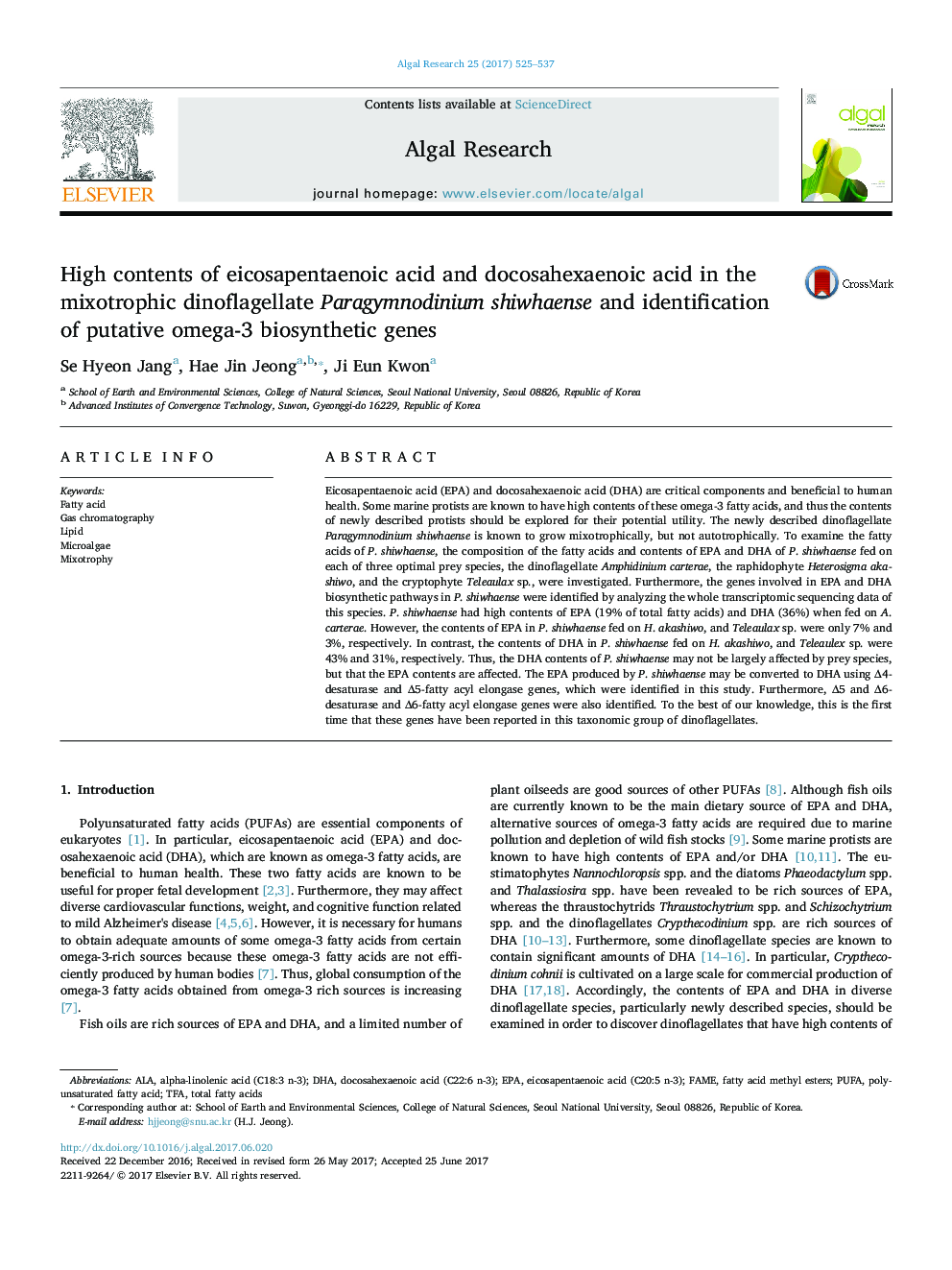| کد مقاله | کد نشریه | سال انتشار | مقاله انگلیسی | نسخه تمام متن |
|---|---|---|---|---|
| 5478405 | 1521808 | 2017 | 13 صفحه PDF | دانلود رایگان |
عنوان انگلیسی مقاله ISI
High contents of eicosapentaenoic acid and docosahexaenoic acid in the mixotrophic dinoflagellate Paragymnodinium shiwhaense and identification of putative omega-3 biosynthetic genes
دانلود مقاله + سفارش ترجمه
دانلود مقاله ISI انگلیسی
رایگان برای ایرانیان
کلمات کلیدی
EPATFAALAMixotrophyFatty acid - اسید چربPolyunsaturated fatty acid - اسید چرب غیر اشباعPUFA - اسید چرب چند غیراشباعDHA - دوکوساهگزائنوئیک اسیدMicroalgae - ریز جلبک هاLipid - لیپیدFAME یا fatty acid methyl esters - متیل استرهای اسید چربfatty acid methyl esters - متیل استرهای اسید چربGas chromatography - کروماتوگرافی گازیTotal fatty acids - کل اسیدهای چرب
موضوعات مرتبط
مهندسی و علوم پایه
مهندسی انرژی
انرژی های تجدید پذیر، توسعه پایدار و محیط زیست
پیش نمایش صفحه اول مقاله

چکیده انگلیسی
Eicosapentaenoic acid (EPA) and docosahexaenoic acid (DHA) are critical components and beneficial to human health. Some marine protists are known to have high contents of these omega-3 fatty acids, and thus the contents of newly described protists should be explored for their potential utility. The newly described dinoflagellate Paragymnodinium shiwhaense is known to grow mixotrophically, but not autotrophically. To examine the fatty acids of P. shiwhaense, the composition of the fatty acids and contents of EPA and DHA of P. shiwhaense fed on each of three optimal prey species, the dinoflagellate Amphidinium carterae, the raphidophyte Heterosigma akashiwo, and the cryptophyte Teleaulax sp., were investigated. Furthermore, the genes involved in EPA and DHA biosynthetic pathways in P. shiwhaense were identified by analyzing the whole transcriptomic sequencing data of this species. P. shiwhaense had high contents of EPA (19% of total fatty acids) and DHA (36%) when fed on A. carterae. However, the contents of EPA in P. shiwhaense fed on H. akashiwo, and Teleaulax sp. were only 7% and 3%, respectively. In contrast, the contents of DHA in P. shiwhaense fed on H. akashiwo, and Teleaulex sp. were 43% and 31%, respectively. Thus, the DHA contents of P. shiwhaense may not be largely affected by prey species, but that the EPA contents are affected. The EPA produced by P. shiwhaense may be converted to DHA using Î4-desaturase and Î5-fatty acyl elongase genes, which were identified in this study. Furthermore, Î5 and Î6-desaturase and Î6-fatty acyl elongase genes were also identified. To the best of our knowledge, this is the first time that these genes have been reported in this taxonomic group of dinoflagellates.
ناشر
Database: Elsevier - ScienceDirect (ساینس دایرکت)
Journal: Algal Research - Volume 25, July 2017, Pages 525-537
Journal: Algal Research - Volume 25, July 2017, Pages 525-537
نویسندگان
Se Hyeon Jang, Hae Jin Jeong, Ji Eun Kwon,